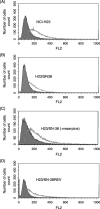Role of ABCG2 as a biomarker for predicting resistance to CPT-11/SN-38 in lung cancer
- PMID: 16542215
- PMCID: PMC11159967
- DOI: 10.1111/j.1349-7006.2006.00164.x
Role of ABCG2 as a biomarker for predicting resistance to CPT-11/SN-38 in lung cancer
Abstract
To examine the mechanism of resistance to 7-ethyl-10-hydroxycamptothecin (SN-38) in lung cancer, we continuously exposed the non-small-cell lung cancer (NSCLC) cell line NCI-H23 to SN-38 and selected the SN-38-resistant clone H23/SN-38. After 2 months of culturing in SN-38-free conditions, H23/SN-38 cells recovered their sensitivity to SN-38 and were subsequently established as the revertant H23/SN-38REV cell line. Because H23/SN-38 cells show cross resistance to certain anticancer drugs, such as topotecan, etoposide, doxorubicin and mitoxantrone, we examined the gene and protein expression levels of drug efflux transporters of the ATP-binding cassette (ABC) family. We found that both gene and protein expression of ABCG2/BCRP (ABCG2) in H23/SN-38 cells was increased compared with that in NCI-H23 cells and H23/SN-38REV cells. The cellular accumulation of topotecan in H23/SN-38 cells was decreased compared with that in NCI-H23 and H23/SN-38REV cells, and treatment with reserpine (an inhibitor of ABCG2) increased the cellular accumulation of topotecan in H23/SN-38 cells. Furthermore, treatment with reserpine also altered the sensitivity of H23/SN-38 cells to SN-38. These results indicate that the upregulation of ABCG2 was functional, and related to the resistance of H23/SN-38 cells to SN-38. Moreover, we found that gene expression levels of ABCG2 were significantly correlated with the concentration of SN-38 for 50% cell survival in 13 NSCLC cells (r=0.592, P<0.05). The present results indicate that the induction of ABCG2 by SN-38 does confer acquired resistance to CPT-11/SN-38, but the induction of ABCG2 and subsequent drug resistance are reversible. However, the expression level of ABCG2 may be a useful indicator of CPT-11/SN-38 activity in lung cancer.
Figures




References
-
- Kubota N, Kanzawa F, Nishio K et al. Detection of topoisomerase I gene mutation in CPT‐11 resistance lung cancer cell lines. Biochem Biophys Res Commun 1992; 188: 571–7. - PubMed
-
- Oguri T, Takahashi T, Miyazaki M et al. UGT1A10 is responsible for SN‐38 glucuronidation and its expression in human lung cancers. Anticancer Res 2004; 24: 2893–6. - PubMed
MeSH terms
Substances
LinkOut - more resources
Full Text Sources
Medical

